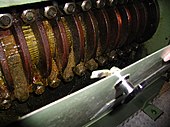Oil mill

An oil mill is the production facility for the production of vegetable oils from oil seeds and fruits . When it comes to raw materials, a distinction is made between oil plants in which the pulp is used (such as olive tree , oil palm ) and oil fruits in which the seeds are used ( soy , sunflower , rape ). Oil mills process the raw materials into oils and fats as well as oil meal ( press cake ). The vegetable oils are used as food and feed as well as in the technical area ( oleochemicals , biofuels ).
Central and decentralized oil mills
Vegetable oils are obtained by pressing parts of plants . The vegetable oil is produced in central or decentralized oil mills . Central oil mills process up to 4000 t of oilseed per day using hot pressing and, if necessary, a subsequent extraction . The oil yield of industrial plants is high. The daily processing capacity of decentralized oil mills, on the other hand, is between 0.5 t and 25 t of oilseed. The seeds are cold pressed ( cold pressing ), which results in native vegetable oil. The oil yield of the facilities that usually work in an agricultural environment is lower, with higher residual fat contents in the press cake.
Procedure
The production processes of centralized and decentralized oil extraction differ significantly. The central element in both, however, is the pressing ( screw press or strainer-rod screw press). Other methods of producing vegetable oil are:
- extraction
In this process, mucilage is extracted and the vegetable oil is extracted from the plant cells using solvents ( hexane ). The mixture of hexane and oil called “ miscella ” is separated into three components in the distillation . The oil is processed in such a way that it can be further processed as vegetable oil. The recovered hexane is used for further extraction processes.
- Centrifugation
A centrifugation process is used particularly in the production of olive oil . The pulp, which may have been mixed with water and heated, is centrifuged here at around 20,000 revolutions per minute.
raw materials
The seeds or the pulp of plants are used as raw materials. Worldwide there are many thousands of oil plants that could be used as raw material suppliers. Oil mills in Europe mainly process the oilseeds of rapeseed , soy , sunflower , corn and cotton , as well as olives , various nuts, safflower and grape seeds . The oil palm for the production of palm oil and palm kernel oil as well as the coconut palm ( coconut fat ) are also of great importance worldwide .
Economical meaning
There are around 20 central oil mills in Germany, mostly located on large waterways for efficient raw material supply and integrated into national or international corporations. Supply and demand (pricing) are usually at the Mercantile Exchange in Chicago traded. There are also around 600 smaller, decentralized oil mills, most of which are active in the agricultural environment in regional cycles.
In addition to domestic products, the central oil mills also process imported seeds, especially soy seeds. In addition to the marketing of vegetable oil, the marketing of the by- product press cake is of economic importance for the decentralized oil mills . The characteristic of decentralized oil mills are the short transport routes for the seeds and the finished products. Due to the large number and diversity of the oil mills, a continuous supply of vegetable oil is guaranteed.
The majority of production in both central and decentralized plants is currently used for fuel production. Edible oils and feed oils as well as lubricants and release agents are also produced. Products from central oil mills are usually fully refined vegetable oils, while so-called cold-pressed vegetable oils are produced in decentralized plants through gentle oilseed processing, which do not go through any refining steps.
history

As a food, vegetable oil has a very long history. The process of squeezing vegetable oil from the seeds and fruits emerged in this context. Oil mills have been known at least since ancient Greece. Numerous mills were found in Olynth , but the city was destroyed in 348 BC. Chr. Destroyed. In the 19th century there were 4,000 oil mills in Germany. With the beginning of industrialization in the century before last, centralization also began in this area. Through overseas trade , partly also through the exploitation of colonial areas in countries in Africa, large quantities of palm kernels and peanuts were imported into Europe and oil was pressed from them.
Since the early 1990s there has been a revival in the decentralization of the oil mills. One of the oldest, still producing oil mills, founded in 1650, today under monument protection standing, linseed oil mill (Braun mill) in Pfaffroda .
At least ten of the large oil mills are subsidiaries of large international companies such as Bunge Limited , Cargill or Archer Daniels Midland . More than half of the decentralized oil mills are located in southern Germany, particularly in Bavaria.
Historic oil mills

The Berschweiler oil mill and the Brandhöfer mill near Gschwend are historical oil mills that are no longer in operation, but whose original technology has been fully preserved.
Traditional oil mills were originally water mills in the German-speaking area . They consisted of a seed pounding machine, a roasting kettle and a so-called mallet wedge press . The process of extracting oil has been known as oil hammering . The oil miller was often called the oil hammer .
Various oil mills can be found in open-air museums , for example in the Vogtsbauernhof (Black Forest), in Fürth im Ostertal (Wern oil mill) and in the Roscheider Hof (Upper Moselle). The Herzsche Ölmühle in Wittenberge on the Elbe, founded in 1823 and expanded to include the granary in 1856, now forms the backdrop for the Wittenberge Elbland Festival . In the Tiengen oil mill , the historical production process is shown as part of demonstrations.
The listed oil mill of the vinegar and mustard factory Ph. Leman GmbH has been in continuous operation since 1923 . Previously, here with mustard seed and rapeseed primarily beechnuts pressed.
Web links
- Edgar Remmele (Technology and Promotion Center TFZ): Handbook Production of Rapeseed Oil Fuel in Decentralized Oil Extraction Plants. (PDF file; 4.53 MB) Published by the Agency for Renewable Raw Materials e. V., Gülzow 2008; ISBN 978-3-9803927-1-6 .
Individual evidence
- ^ Board of Trustees for Technology and Construction in Agriculture V .: Decentralized oilseed processing - working paper 267. Landwirtschaftsverlag GmbH, Münster-Hiltrup 1999; Pp. 1-130
- ↑ Fediol: Oils and fats Production by Main Countries 2005/06
- ↑ BA Widmann: Background and objectives of decentralized oilseed processing , in: Kuratorium für Technik und Bauwesen in der Landwirtschaft e. V. (Ed.), Dezentrale Ölsaatenverarbeitung, Darmstadt, 2005, pp. 13–21
- ↑ Helmuth Schneider: The Gifts of Prometheus P. 94f. in: Wolfgang König (Ed.): Propylaea History of Technology - Volume 1 , Propylaea, Berlin 1997.
- ^ History of the Dörnthal oil mill , accessed on December 26, 2014
- ↑ Member companies of the Association of the Oil Seed Processing Industry in Germany. V. (OVID) ( Memento of the original dated December 7, 2008 in the Internet Archive ) Info: The archive link was inserted automatically and has not yet been checked. Please check the original and archive link according to the instructions and then remove this notice.
- ↑ Decentralized oil mills in Germany , website of the Technologie- und Förderzentrums e. V., Bavaria
- ↑ Detailed description of the mechanics and technology of historical oil mills by Peter Nikolaus Caspar Egen : Oil mills . In: ders .: Studies on the effect of some existing waterworks in Rhineland-Westphalia , ed. from the Ministry of the Interior for Trade, Industry and Construction, Part I – II. A. Petsch, Berlin 1831, pp. 158-167 ( Google Books ).
- ^ Moritz Rühlmann: Contribution to the history of the oil mills . In: Mittheilungen des Hanover Trade Association, 1875 p. 164
- ↑ Berthold Moog: The oil mill . In: Mühlenbrief No. 10, October 2007 , ed. from the Association of Swiss Mill Friends.
- ↑ The oil miller . In: Professions der Welt , ed. by S. and M. Sallmann.




